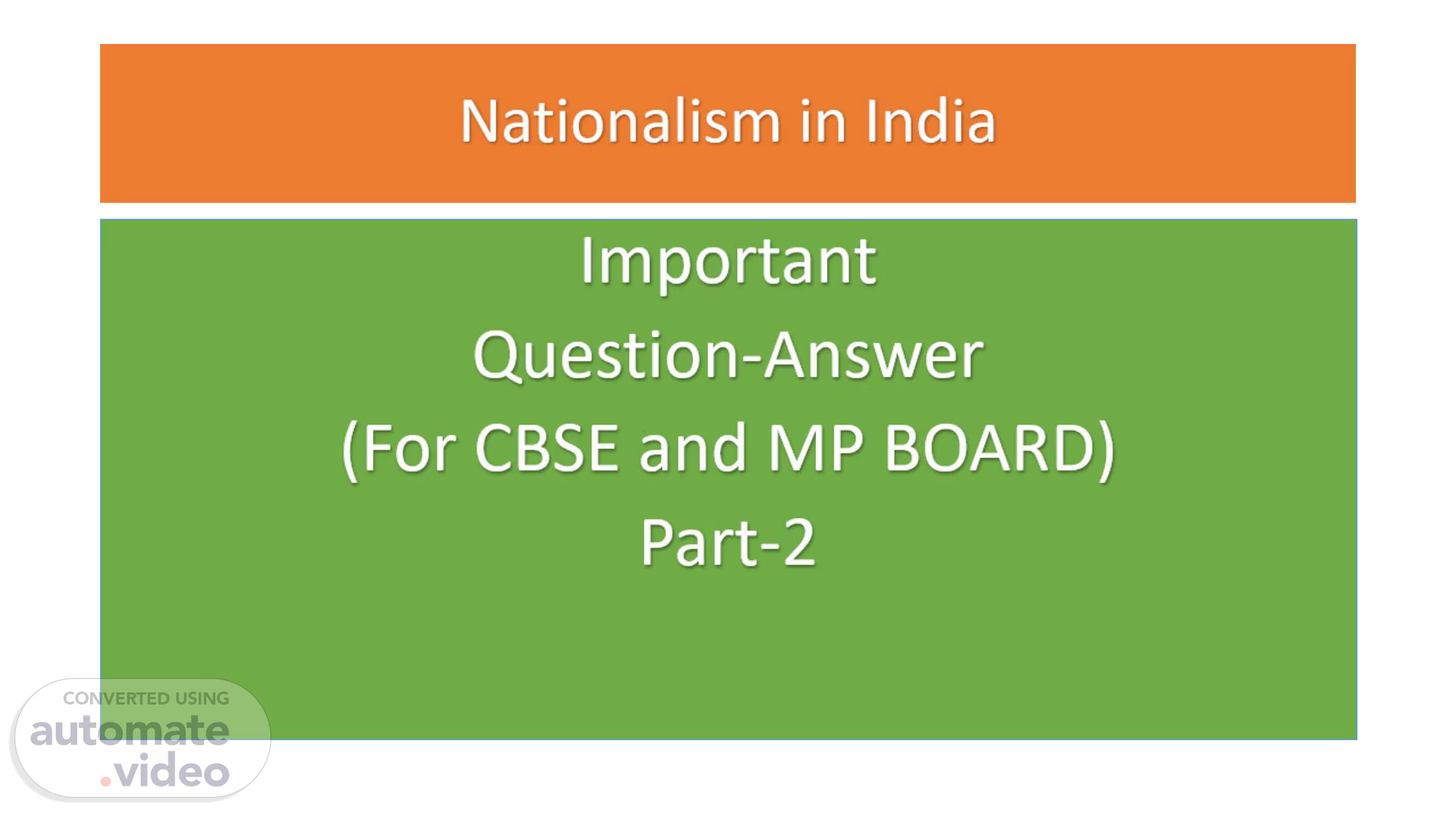Scene 1 (0s)
[Audio] Nationalism in India Important Question-Answer (For C-B-S-E and MP board) Part-2.
Scene 2 (8s)
[Audio] Question-1)How The First World War Helped in The Growth of The National Movement in India. Answer In 1914, when the first world war had began, the British government included India also in this war. The american President and Prime minister declared that this war was fighting to secure the rights of demcracy, thus the indian people should provide full support in this war. Mahatma gandhi assured the British government to give full support to operate the war. Many Indians were recruited during World War. This war awakened the feelings of nationalism. The Indian leader demanded that if Britain was fighting the war for the sake of democracy, its moral duty is to establish self rule in India after the war..
Scene 3 (54s)
[Audio] Question-2)Why indians were outraged by the rowlatt Act(1919)? Answer The Rowlatt Act was passed in 1919 by the British government. It gave enormous powers to the government. "Rowlatt Act" which gave power to the police to arrest any person without any reason. The Prime objective of Rowlatt Act was to suppress the national movements. This act was called as ‘Terroist Criminal Act’ in the history of national movement. Protest agaings the rowlatt Act(1919) There was a nationwide protest against the rowlatt Act (1919). Mahatma gandhi also participated actively in this protest. mahatma gandhi launched satyagraha movement. a nationwide strike was decide on 6th april. railies were organised in various parts of the country. shouting slogans against the rowlatt act. it was a movement in which all rich and poor, higher and lower, hindus and muslims got together..
Scene 4 (1m 57s)
[Audio] Question-3) why gandhiji decided to withdraw the non-cooperation movement? Answer Gandhiji decided to withdraw the Non-Cooperation Movement in February 1922 because The movement was turning violent in many places. He believed that the people were not ready for a nonviolent revolt. On 5 february, 1922 at chauri-chaura in gorakhpur district, uttar pradesh, the excited crowd fired the police station that causes the death of 22 policemen. gandhiji believed in non violence so he called off the movement on 11 feb, 1922. it was the first nationwide movement. after 2 days, mahatma gandhi was punished for 6 year imprisonment by british government..
Scene 5 (2m 48s)
[Audio] Question-4)What is meant by the idea of satyagraha? Answer The idea of satyagraha emphasized the power of truth and the need to search for truth. It suggested that if the cause was true if the struggle was against injustice then physical force was not necessary to fight the oppressor. According to Gandhiji without being aggressive a satyagrahi could win the battle through non-violence. by this struggle, truth was bound to ultimately triumph..
Scene 6 (3m 21s)
[Audio] Question-5) Write a short note on jallianwala bagh masscre? Answer The Rowlatt act was enforced in march 1919. the whole country had protesed against it. the rowlatt act was protested in punjab also. the british government had don lathi charge on many places in punjab. on 10 april, two leaders of congress:Dr satyapal and dr.saifuddin kitchlew were arrested and sent to prison. against these arrest, a protest meeting was organised on 13th april, the baisakhi day in jallianwala bagh. as the meeting started, an army officer general dyer ordered his soldiers to fire on the crowd without any warning. soldiers fired on the crowd due to which more than 800 people died and about 2000 people were injured. this incident ignited the flame of independent and self-government in india.
Scene 7 (4m 16s)
[Audio] Question-6) Write a short note on “the simon commission”. Answer In 1927, the british government appointed a 7 members commission. head of this commision john simon. the objective of commision to prepare report on the consititutional reforms in india. this commison was boycotted because all members of this commison were english and no single representative was indian. when the commision went in india there strikes were organised, black flags were shown. slogans of ‘go back simon’ were shouted. lala lajpat rai died in lathi charge of police in a demonstration against the simon commision..
Scene 8 (4m 55s)
[Audio] Question-7) what was the poona pact? clarify. Answer as british government accepted a demand of ambedkar, gandhiji began a fast unto death. gandhiji believed that separate electorates for dalits would slow down the process of their integration into society. ambedkar understood gandhiji’s position and signed on the poona pact in september 1932. it gave the depressed classes reserved seats in provincial and central legislative councils but they were to be voted in by the general electorate..
